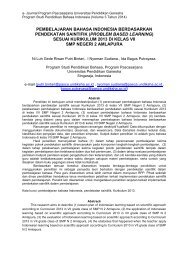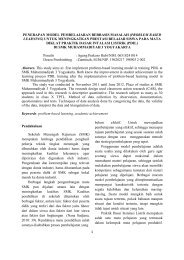Create successful ePaper yourself
Turn your PDF publications into a flip-book with our unique Google optimized e-Paper software.
1 Atomic structure and the periodic table<br />
Test yourself<br />
13 What is the electric charge of a particle with 19 protons and<br />
18 electrons?<br />
14 What is the electric charge of a particle with 7 protons and 10 electrons?<br />
15 What is the electron structure of the P 3− ion?<br />
16 How many protons, neutrons and electrons are there in the 19 F − ion?<br />
17 What is the link between the electron structure of ions and the Group 0<br />
elements?<br />
Show you can...<br />
The table gives some information about six different particles, A, B, C,<br />
D, E and F. Some particles are atoms and some are ions. (The letters<br />
are not chemical symbols).<br />
Particle<br />
Atomic<br />
number<br />
Mass<br />
number<br />
Number of<br />
protons<br />
Number of<br />
neutrons<br />
Number of<br />
electrons<br />
Electronic<br />
structure<br />
A 18 40 2,8,8<br />
B 27 13 2,8<br />
C 20 20 20<br />
D 35 17 2,8,7<br />
E 16 32 18<br />
F 17 20 17<br />
a) Copy and complete the table.<br />
b) Particle C is an atom. Explain, using the information in the table, why<br />
particle C is an atom.<br />
c) Particle E is a negative ion. What is the charge on this ion?<br />
d) Which two atoms are isotopes of the same element?<br />
negatively<br />
charged<br />
electrons<br />
positively<br />
charged<br />
ball<br />
● Development of ideas about the<br />
structure of atoms<br />
The idea that everything was made of particles called atoms was<br />
accepted in the early 1800s after work by John Dalton. At that time,<br />
however, people thought that atoms were the smallest possible<br />
particles and the word atom comes from the Greek word atomos which<br />
means something that cannot be divided.<br />
However, in 1897 the electron was discovered by J.J. Thompson while<br />
carrying out experiments on the conduction of electricity through<br />
gases. He discovered that electrons were tiny, negatively charged<br />
particles that were much smaller and lighter than atoms. He came<br />
up with what was called the ‘plum-pudding’ model of the atom. In<br />
this model, the atom was a ball of positive charge with the negative<br />
electrons spread through the atom.<br />
plum-pudding model of the atom (1897)<br />
A few years later in 1911, this model was replaced following some<br />
remarkable work from Hans Geiger and Ernest Marsden working with<br />
Ernest Rutherford. They fired alpha particles (He 2+ ions) at a very thin<br />
piece of gold foil. They expected the particles to pass straight through<br />
the foil but a tiny fraction were deflected or even bounced back. This<br />
8





